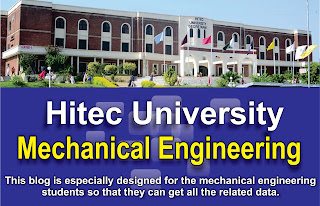Showing posts with label Thermodynamics 2. Show all posts
Thermodynamics
By : Asad Ali Arshad
CHAPTER: Rotodynamics Machinery
BOOK: Applied Thermodynamics by TD Eastop and A McConkey, 5th Edition.
For the complete detail of this chapter download the given slides. The slides consists of complete description, diagrams and derivations.
Rotodynamic Machinery in which a fluid flow freely through impeller or rotor.
BOOK: Applied Thermodynamics by TD Eastop and A McConkey, 5th Edition.
For the complete detail of this chapter download the given slides. The slides consists of complete description, diagrams and derivations.
Rotodynamic Machinery in which a fluid flow freely through impeller or rotor.
- the transfer of energy between fluid and rotor is continuous and
- the change of Angular Momentum of the fluid causes, or is the result of Torque on rotor.
This chapter covers the Basic Theory of Turbines and Compressor used in Steam Plant and Gas Turbine Plant.
Impulse Steam Turbine
- Impulse Turbine
- Takes a high pressure, high-enthalpy fluid.
- Expand it in a Fixed Nozzle.
- Steam coming out through a fixed nozzle at a very high velocity strikes the blades fixed on the periphery of a Rotor.
- Blade change the direction of steam without changing its pressure.
- Force due to change of momentum(by changing the direction) causes the rotation of the turbine shaft.
Fluid flowing through the wheel at a fixed mean radius, then the change of Linear Momentum tangential to the wheel gives a Tangential Force that causes the wheel to rotate.
Assume initially that the fluid is able to enter or leave the wheel passage in the Tangential Direction with an Absolute Velocity at inlet Cai and an Absolute Exit, Cae.
For a fixed blade Cb=0.
For more detail download the given slides the slides consist of complete description and detail of impulse steam turbine.
Thermodynamics
By : Asad Ali ArshadIn these slides we will cover the following topic in detail so for the complete description download the given slides.
A device that exchanges energy with the fluid, using continuously flowing fluid and rotating blades.
e.g Aircraft Engine, Wind Turbine.
- If the device extract energy from fluid generally called as turbine.
- If the device deliver energy to fluid generally called as pump.
turbo machinery is the generic name of all these machines.
Nozzles?
A nozzle is a duct of smoothly varying cross section area in which a steadily flowing fluid can be made to accelerate by a pressure drop along the duct. Nozzles are used in steam turbines, in rockets,in injector and ejector etc.
Diffuser ?
When a fluid is decelerated in a duct causing a rise in pressure along the steam. e.g centrifugal pump etc.
Description of following topic is available in slides so for the detailed learning download the following slides.
- Nozzles Shape
- Critical Pressure Ratio
- Critical Temperature Ratio
- Critical Velocity
- Maximum Mass Flow
- Nozzle off the designed pressure ratio
- CD Nozzles
- Nozzle Efficency
- Length of Nozzle
- The Steam Nozzle
- Stagnation Conditions
Ch-2 Thermo-II Sp-18-Week5.pdf
null
Thernodynamics 2
By : Asad Ali ArshadIn this lecture we will discuss about.Ch-1 Thermo-II Week-3.pdf
null
- What is a turbomachine?
- Schematic of Jet Engine.
- Nozzels
As you know nozzle is a duct of smoothly varying cross section area in which a steady flowing fluid can be made to accelerate by a pressure drop along the duct. e.g nozzles are used in steam and gas turbines, in jet engines, in rocket motors etc.
In this lecture we will discuss the nozzle briefly.- Diffuser
When a fluid is decelerated in a duct, causing a rise in pressure along the stream. Its major applications are centrifugal pumps and ramjet.
- We will also discuss diffuser briefly.
- We have a long discussion on Nozzle Shape.
- Convergent Divergent Nozzle.
- Critical Pressure Drop
- Critical Temperature Ratio
- Critical Velocity
- Maximum Mass Flow
- Nozzle Off the design pressure ratio
- Convergent Nozzle
- Convergent Divergent Nozzle
- Nozzle Efficency
- Length of Nozzle
- The Steam Nozzle
All of the above topics are discussed in detail in the above given slides.
Thermodynamics 2
By : Asad Ali Arshadthermo-lab-1.docx
null
Thermodynamics
Branch of science that studies changes in energy.
Temperature, Pressure, Volumeare driving forces for energy.
Types of Heat
(1) Latent Heat:
Related to phase change i.e. melting of ice. Boilers, Evaporator.
(2) Sensible Heat:
Heat can be sensed (No phase change) e.g. Heaters. Air conditioners.
Laws of Thermodynamics
First Law of thermodynamics:
Energy can neither be created now destroyed but it can be changed from one form to another.
Also called law of conservation of energy.
ein-eout=constant
ein=eout
ΔU=Q+W
Q= Heat exchanged b/w system.
W=Work done.
 |
Second Law of thermodynamics:
Entropy of a system also increases never decreases.
Entropy:
Measure of disorder of energy of a system.
Zeroth Law of thermodynamics:
Kelvin Statement
No device can be worked with single reservoir. .e.g. car-engine.
Clauses Statement
Heat cannot be transferred from low to higher reservoir. E.g. refrigerator
Second Law of thermodynamics:
For a pure crystalline structure entropy is zero at absolute zero.
Microscopic Properties:
Study of each atom or molecule separately.
Macroscopic properties:
Study of each atom or molecule as whole average.
System:
Anything under consideration is system.
Surrounding:
Everything except system is surrounding.
Boundary:
The separation b/w system and surrounding is boundary.
Closed System:
A fixed amount of mass is chosen for study.
Open System:
Thermodynamics 2
By : Asad Ali Arshad
A Nozzle is a duct of smoothly varying cross-sectional area in
which a steadily flowing fluid can be made to accelerate by a
pressure drop along the duct.
E.g., nozzles are used in steam and gas turbines, in jet
engines, in rocket motors, in flow measurement, in
injectors, in ejectors etc.
Diffuser: When a fluid is decelerated in a duct, causing a rise in
pressure along the stream.
Major applications: Centrifugal Compressor and
the Ramjet.Analysis here will be restricted to One-dimensional Flow it is assumed that the Fluid Velocity, and the Fluid Properties, change only in the direction of the flow.
Fluid velocity is assumed to remain constant at a mean value across the cross-section of the duct.
Friction will not be analyzed Fundamentally, suitable efficiencies or coefficients being adopted to allow
for the departure from the ideal friction less case.
Further Explanation of variation of Nozzle-Areawith decreasing Pressure.
At low velocities the density is constant and therefore as the area gets smaller (Convergent Nozzle) the velocity must increase to keep ρVA constant. This is the case we are used to in our day to day lives. In reality, as velocity increases, the decreasing static pressure allows the air to expand. So as air accelerates through a convergent duct its volume gets bigger. At speeds closer to the speed of sound, the density is not a constant any more. At these speeds the fluid is sort of stretched out and less dense: the higher the velocity the lesser dense the fluid becomes. At this point we notice that the density and the velocity work in opposite directions in the quantity ρVA, that is, meanwhile more V brings ρVA higher, less ρ brings ρVA lower.
If in the nozzle we continue to make A smaller (convergent), eventually we will reach the point where ρ out-powers V in the expression ρVA and the velocity cannot go higher anymore. In other words, ρV reaches its maximum. Any increase in V will cause a decrease in ρ such as the quantity ρVA would be smaller and this is not possible, ρVA must be a constant. The value of V when this maximum happens is the speed of sound for this particular fluid and conditions. since the quantity ρV is at its maximum, the mass flow rate ρVA is at its maximum as well. In other words, it is impossible to increase the mass flow rate no matter what and the nozzle is said to be choked.
After the speed of sound is reached, if we increase A (divergent nozzle), V will continue to go up and ρ will continue to go down in such a way that ρVA will remain still constant. Effectively the fluid now behaves the opposite way, it will increase its velocity as the area increases and all because of the inverse relationship between the density and the velocity of the fluid.
|
Hitec Mechanical Engineering
Mechanical Engineeirng Hitec Mechanical Engineering As we know Mechanical Engineering is the branch of engineering dealing with the des...
















